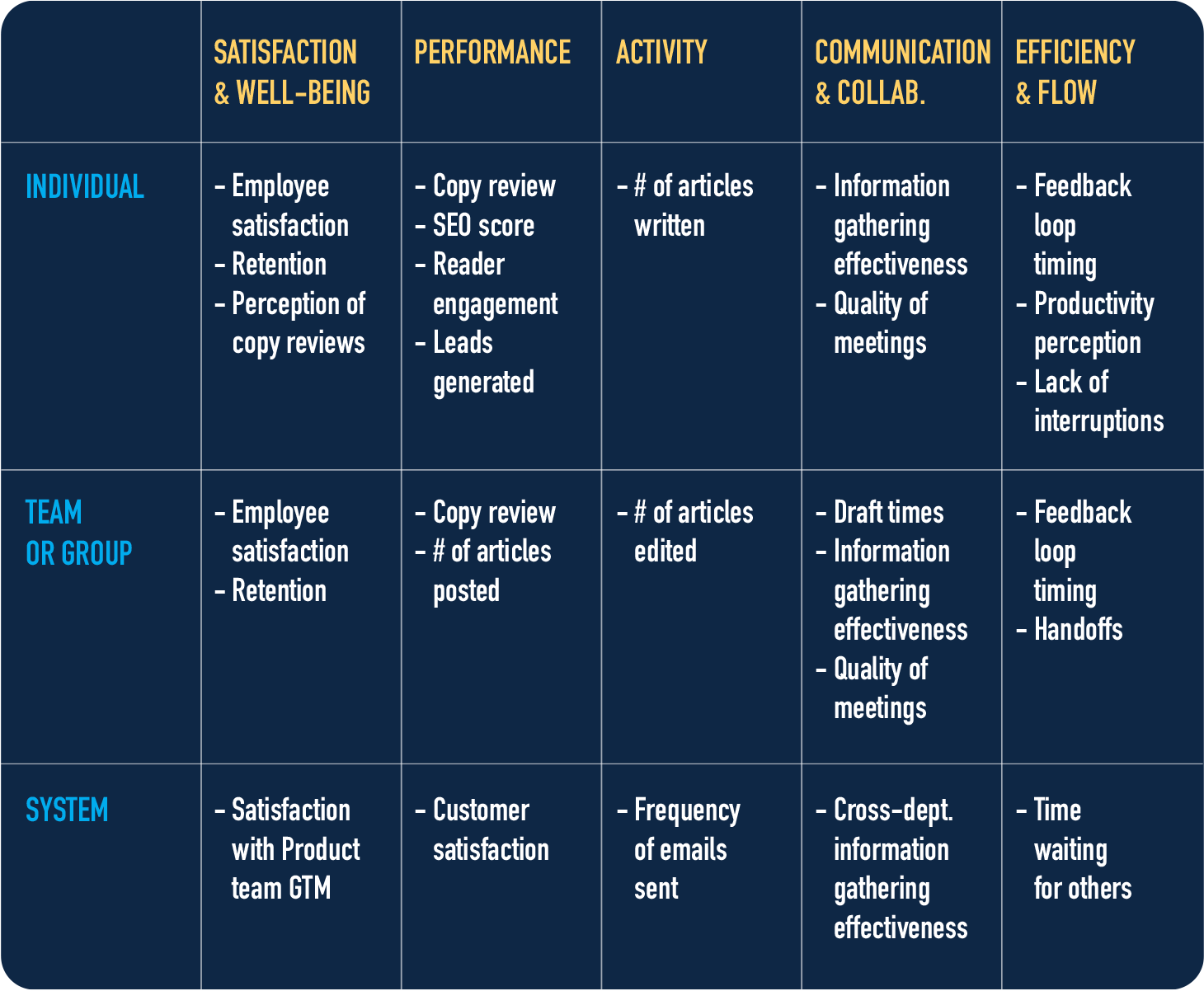Reach for the Stars with the SPACE Productivity Framework
July 27, 2023

Victoria Donovan
Content Specialist at Sync

How do you define productivity?
It’s a loaded word, and it means something different to everyone. In Slack’s recent State Of Work survey, 27% of executives primarily measure productivity by visible activity, whereas 27% of desk workers measure it by achieving KPIs and goals.
It’s these exact differences in opinionated metrics that make it hard for leaders to effectively evaluate and encourage proper productivity. But fear not, there’s an out-of-this-world solution that’s changing how people quantify getting your best work done.
The SPACE framework offers a holistic picture of productivity, where there is no single metric.
Who created the SPACE framework?
The SPACE framework was developed by Nicole Forsgren from GitHub, Margaret-Anne Storey from the University of Victoria, and researchers from Microsoft, way back in 2021. Their objective was to create a multidimensional framework to help managers clearly define, measure, and predict productivity. And while their research focused on developers and engineers (because it’s particularly hard to measure productivity within those fields) the framework can be applied to any employee or team. Even yours!
What is the SPACE framework?
SPACE is an acronym, outlining five important elements of productivity:
- Satisfaction & Well-being
- Performance
- Activity
- Communication & Collaboration
- Efficiency & Flow
The idea is that by using “a constellation of metrics,” managers become better leaders and employees produce better results. As a bonus, SPACE differs from other productivity frameworks because it debunks common productivity misconceptions along the way. The SPACE framework tells us that:
- Productivity is not all about activity
- Productivity is not only about individual performance
- One productivity metric alone cannot tell us everything
- Productivity measures are not just for managers
- Productivity is not only about systems and tools
In short, SPACE provides a holistic way for you and your employees to think rationally about productivity in a much bigger space. Here are the details:
Satisfaction & Well-being
Satisfaction measures how happy, healthy, and fulfilled your employees are. When you’re satisfied with the work you’re doing and the company you work for, you are more likely to be productive.
Performance
This measures the outcome of a process, rather than the output. A copywriter might output thousands of words, but do those words connect with the intended audience?
Activity
Activity is the opposite of Performance but is just as relevant. It captures all the actions or outputs that happen, big or small, and is a strong measure of how time is being spent.
Communication & Collaboration
Teamwork makes the dream work, which means measuring how well people work together is key. Here you look for effective lines of communication, a supportive work environment, and organic collaboration.
Efficiency & Flow
Getting into a focused headspace typically involves removing all sources of interruption and delay. This is vital to improved productivity because fun fact: you’re twice as likely to make a mistake after being interrupted.
How do you use the SPACE framework for your team?
While SPACE was originally designed for developers and engineers, the principles can be applied to any employee or team. You can use SPACE to enhance productivity on three levels:
- Individual
- Team/group
- System (the end-to-end work through a system)
The key is that for each level, you need to define a set of metrics that work for both you and your team. More importantly, once defined, these metrics become part of every conversation, including weekly 1:1’s, DSU’s, Level-10’s, team meetings, project kickoff meetings, post-mortems…you get the idea. Try these to start:
- Satisfaction & Well-being – measure happiness scores, how people are feeling (at work and at home), and measure the frequency of highlights and wins
- Performance – measure outcomes as they relate to projects, including revenue, churn, engagement, or customer feedback
- Activity – measure the overall output of work as it compares to others, project progress, and if projects meet deadlines
- Communication & Collaboration – measure meeting frequency, participation in collaborative workspaces, and awareness of the team at large on tasks
- Efficiency & Flow – measure the amount of focus time, interruptions, last-minute projects, or how often goalposts are moved
Life hack: a useful way to quantify all of this is through visualization. SPACE can be explored via a simple table available to both managers and employees. Here’s what this would look like for a Copywriter:

Want to go deeper into SPACE?
Furthermore, once you’ve established a regular cadence with SPACE at the overall level, you can also look at the framework in terms of more specific parts of work. Use each element to evaluate and optimize productivity in relation to tasks such as recurring events, projects, meetings, and cross-departmental efforts. In our Copywriting example, we would look closely at the processes, tools, and resources used specifically during the task of writing content.
How to get the most out of the SPACE framework
To ensure a successful launch, use these additional recommendations to help your team reach for the stars.
- Use at least 3 or more elements to get the most well-rounded understanding of productivity.
- Limit your metrics to just one or two for each element. The power of the SPACE framework comes from combining multiple elements.
- Use perceptual data for at least one metric, such as a survey, to get a more complete picture.
- Be wary of bias as data points like age and experience can affect elements of SPACE.
The benefits of the SPACE framework
Enabling people and teams to work effectively may seem daunting while peering through a tiny telescope. But it’s easy when you look at the big picture and get everyone involved. The SPACE framework will give you:
- More prioritization and focus, which translates to better alignment with company objectives, better clarity and focus, and easier tracking of progress.
- Happier employees because your team will feel heard, valued, and empowered.
- Quicker adaptation, as the SPACE framework was developed partly to help managers navigate the productivity landscape post-COVID.
- A more balanced perspective of work, as SPACE forces you to measure both the quality and quantity of work.
- Flexibility because unlike most frameworks, SPACE works on your terms, using metrics that matter to you.
Effective metrics and over-the-moon outcomes
Employees want to be productive. Teams want to work together. As leaders, we should be leading in the most effective, holistic way possible. The SPACE framework aims to create happier, healthier workplaces with metrics that reflect what’s happening on the ground. Or maybe the moon. It’s not rocket science.
